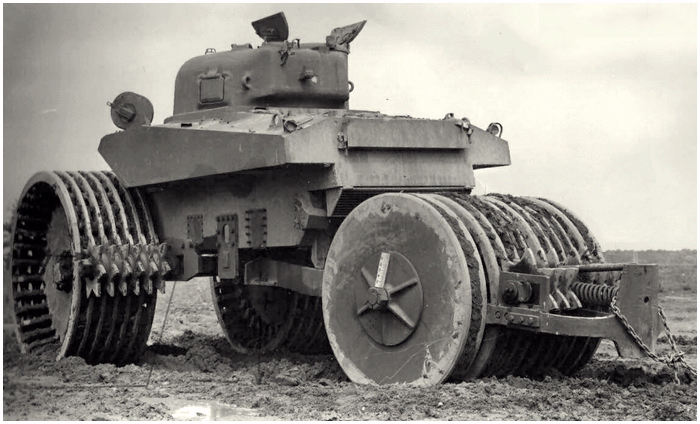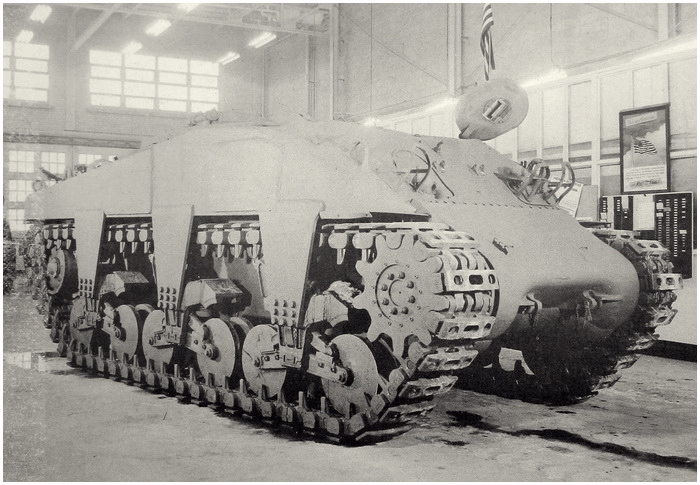|
The Americans also go for the flail

In 1943 in Afrika testing with an M4 Sherman Flail T3 Scorpion
The T3 was flail concept of the British Scorpion. The first tests in the United States
were on the M4A4. The flail rotor was driven with a separate engine on the right of the tank. The chains of
the T3 swept in a spiral pattern. At the front of the tank a shield was placed to protect it from debris
and rocks. Thirty T3’s were produced by the Pressed Steel Car Company and shipped to North Africa in May 1943.
A total of 41 T3’s were produced by Pressed Steel Car Comp. During the outbreak from Anzio towards Rome,
the T3’s drove at the front. But the vehicles were often broken down because of the exploding mines.
Soon afterwards the T3’s were pulled back from the front.

A T3E1 without the flank-engine and without the chains
With the T3E1 the separate engine on the right was deleted. Instead the M4’s own
engine was used to rotate de rotor. The weight of the was reduced with a half, to 2540 kilos.
The speed of the rotor went from 75 rpm (T3) to 178 rpm with the T3E1. Testing brought to light
that, just as with the British Crab I, only on a smooth surface the flail worked at its best.
Crews did not liked the T3 and T3E1 because of the rocks and dust the flail produced during operations.

A small test contraption of the
Rotoflail
Some testing was done with a larger diameter rotor, the so called
Rotoflail. It was a big step forwards, but the war was almost
over and further testing was stopped.

The final flail-version for an M4,
in this case an M4A3 (HVSS) 76mm
The last version with a flail-system was built for the M4A3’s who
were put into action in the Korean War in the fifties of the last century. These rotor
were powered once again by a separate engine on the right.
In the 2nd World War in the field, often some homemade solutions were built by
handy mechanics, such as the one by the ‘Seabees’ for the US. Marine Corps.

An M4A2 of the US. Marine Corps with an
improvised flail constructed by the 'Seabees'
(1944)
Meanwhile the British exeprimented with other devices, such as with a plow. They tested the device on sandy beaches in front of an M4 Sherman. The idea was to 'plow' the landmines to the surface and shove them to the side. This to prevent them from exploding, and that no kraters were created, so vehicles would not get stuck into them.

A British Sherman with the 'shove them to te side' system
America continues the experiments
Were the previous models based on the flail or roller system. The American engineers also, just as the British, experimented with a 'shove them to te side' system. An example of that system was the T5. The principle was simple,... a Bulldozer blade with a special angle pushed under a mine and drove it to the side of the road. Previous versions, the T4 and the T4E1, with a diagonal blade in a flat angle were no success and were not further developed. The V-shaped blade of the T5 had also a curved edge on top of the blade to prevented mines from toppling over the blade and fall in the running path of the tank. After
some adjustments the final version was named the T5E1. Another model, the T6, with
the same principal, was tested and developed to the T6E1 and T6E2 before testing was
stopped. The solutions of both the version, T5E1 and the T6E2 were combined to become
the T5E2. Fine tuning let to the T5E3. At Plante-Choate 100 T5E3’s were produced from
March till May 1945. It was the only type of mine clearing tank shipped to the
frontline in the Pacific Ocean.

Een T5E3
Lt-Col. A.R. Williams designed a very ingenious system for mine detonation.
At the front of the tank 18 mini pile-drivers were installed. It was connected to the front
wheel. When activated the ‘ram’ hammered out of the cylinder. When a mine detonated, the
ram jolted back into the cylinder that had a heavy spring as a brake, just as a shock absorber.

A T8 with three ‘pile-drivers’
It was designated as the T8, but had as nickname Johnny Walker.
The first test were done with three ‘pile-drivers’ at the front of an M4A4. The test were not
a great success, and an another test was done with six drivers. This T8 was somewhat better,
but working in rough ground was a problem. During testing the hammers were damaged and the
testing was stopped.

The T8 test vehicle with six ‘hammers’
The roller system once again re-surfaced. The next idea was
the use of a giant roller, used for ground flattening. The T9 had a big cylinder
that was covered with 5 inch spikes. A push-frame had a extensible axel what made it
a difficult to operate. The weight of the whole contraption was 84.000 pounds.

The last version of the T9E1 with lighter installation.
It’s successor, the mine exploder T9E1, had a smaller cylinder with smaller spikes.
The wall of the cylinder was made thinner. This reduced the weight to 64.000 pounds. The extensible
axel, to slide the roller outwards, was 236 inches in the short position, and 314 inches in the
outstretched position. Because it’s contraption was almost as heavy as the M4 that pushed the
thing, it was during operations very hard to maneuver with it, so further development was stopped.
The Big Foot M4
Sherman T10
Maybe the most eccentric and futuristic idea to clear mines, was the T10.
It was developed out of the Tricycle constructed by the NDRC. The idea was
to built small engines into the giant 96 inches front wheels (so it could drive
without the internal engine of the tank). Between the traction wheels were six
heavy discs loosely placed around the axel so it good follow the rough ground easy.
It had a long frame at the rear with a wheel (were it’s nickname came from;
Tricycle). Test were done at Aberdeen with wheels without the engines
and the discs in the middle. It worked well, but it was not further developed.

The M4A2 T10 stood high on her wheels
The T10 looked
a lot of the Big Foot monstertrucks that are used in shows today
The Tricycle dropped the idea to place engines inside
the wheels, and used the traction of the internal engine. Fisher was given de
order to produce a pilot with the designation T10. The standard bogies with tracks
were removed from an M4A2. The underside was thickened with 25mm steel. The side of
the tank was adapted to give room for the enormous 96 inch wheels. The wheel at the
rear was 72 inches in diameter.

The T10 looks like the now populair
Big Foot monster trucks (below)

The M4A2 stood 55 half inches above the ground.
The width of the path was 153 inches (the front wheels had a width of 36-half inch each).
The 116.400 pounds heavy tank could reach a speed of 3 km/h when it was clearing mines
(on a clear road it could drive 10 km/h). In June, 1944 the T10 was tested, but it was
evident that the weight was the drawback in action.
During the war a lot of ideas and testing was done to clear mines, even
mortars were used to detonate mines. Or, a sort of conveyor belt was used with an explosive
at the end that would detonate just above the ground, so it would trigger mines hidden in
the ground. This Pancake, as it was called, was a flop.
 
A demolition snake
M2A1 constructed in the field for use
Another idea was the so called
demolition snake M2, a long tube of 400 feet long, filled with 3200 pounds of explosives
(a total weight of 12.500 pounds). The tank pushed it into a minefield. After detonation there was
a path of 320 feet in length and 16 to 20 feet wide ’cleansed’. During the fighting around Metz, France in the autum of 1944, Patton his
Third Army, and the attached 735th Tank Battalion used once the demolition snake M2A1.
The M3 had instead of a steel tube,
an aluminum boxed tube. This brought the weight down with 3500 pounds (in comparison to the M2). The explosive charge was more than 4400 pounds (2000 kilo). The M3 had a maximum lenght of 122 meter. But it is not sure if the M3 was ever used during the war.

The T15 in January, 1945 at
Chrysler.
(Notice the heavy rubber ‘stoppers’ above the wheels
to ‘break’
the shock of an explosion)
The last mine clearing Sherman I mention here is the T15 and the T15E1. It was
developed out of the T14, an almost indestructible Sherman tank. The underside was strengthened
and the suspension with the tracks were made very strong, so it could drive shockproof into a
minefield. But the tank was far to heavy in muddy terrain. Instead of a heavy indestructible tank,
it was better to use a lighter one that could deal with a ‘punch’. Chrysel developed the first mine
resistant vehicle T15. The underside was made thicker and the bogies and suspension were covered in
armor plating. The turret was deleted and a 25mm thick armored plate covered the hole. In this plate an
oval hatch and a cupola for the commander was placed. This T15 had a weight of 72.7000 pounds (just 2.7000
pounds more than the standard M4 tank).

The T15E1 with the
stud-tracks
The next development of the T15 was the T51E1. It looked exact as it’s predecessor,
but had heavier tracks with studs on the track. In the cover plate (where the turret used to be)
two hatches were placed, one cupola for the commander, and a two-split hatch with a .50 machinegun
(the same hatches as on the M4A1 76mm, but in mirror). During testing at Aberdeen both, the T15
and T15E1 had their transmissions damaged when it struck a single T6E1 anti-tank mine.
The tracks on both models could sustain the explosions of mines, but the T15E1 was a bit
better that the T15 (which had parts damaged of the suspension.
Plannes were made to built pilots of the T15E2 and the T15E3. Bud both projects
were at an early stage canceled.
At the end it was concluded that the flail was the best, even when it was not
the perfect solution. The most clumsy was the T1E3 with her enormous wheel on the front. The
ugliest had to be the T9 (and also difficult to work with). The most attractive one in my view,
was the T10. It’s a pity not one example of the Big Foot was preserved.
Click on
BACK
to return to the M4
Sherman tank pages.
Or, you may return to the
Normandy Pages
|